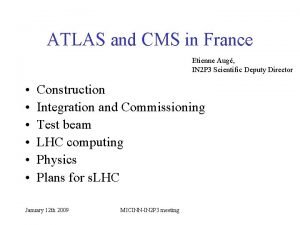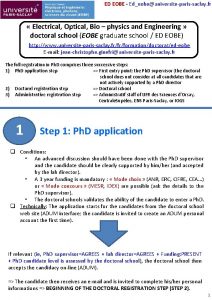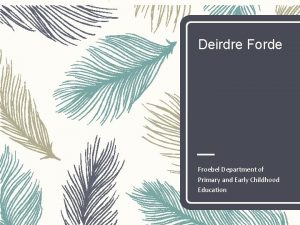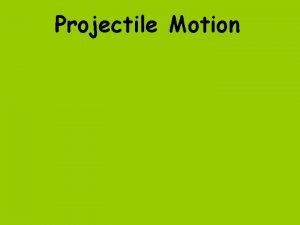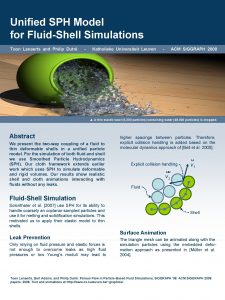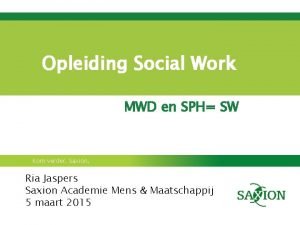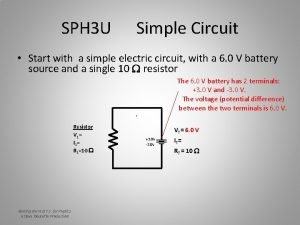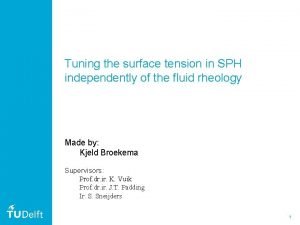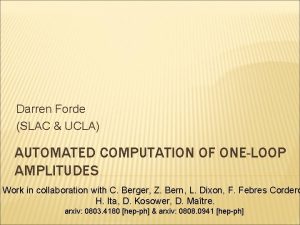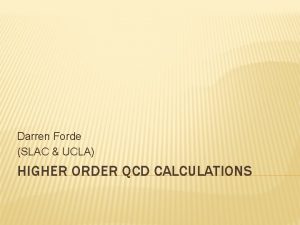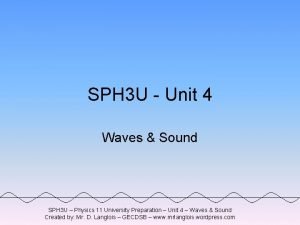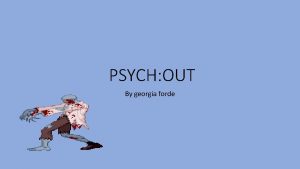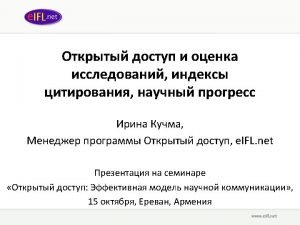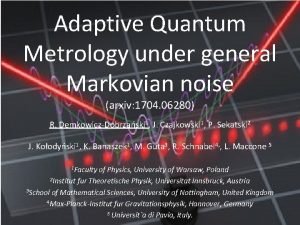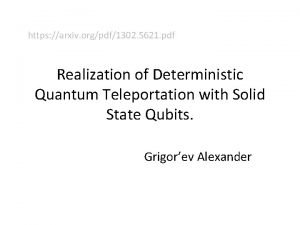Darren Forde SPh T Saclay arxiv hepth0507292 arxiv


![The unitarity bootstrap technique Focus on this Cut construction techniques [Bern, Dixon, Dunbar, Kosower] The unitarity bootstrap technique Focus on this Cut construction techniques [Bern, Dixon, Dunbar, Kosower]](https://slidetodoc.com/presentation_image/0ddb49018c98a268bec5df2c3b74a238/image-3.jpg)


![On-shell recurrence relations [Britto, Cachazo, Feng], [Britto, Cachazo, Feng, Witten], [Bern, Dixon, Kosower] Calculate On-shell recurrence relations [Britto, Cachazo, Feng], [Britto, Cachazo, Feng, Witten], [Bern, Dixon, Kosower] Calculate](https://slidetodoc.com/presentation_image/0ddb49018c98a268bec5df2c3b74a238/image-6.jpg)

![On-shell recurrence for [ Inf An] General form of a shifted amplitude in z On-shell recurrence for [ Inf An] General form of a shifted amplitude in z](https://slidetodoc.com/presentation_image/0ddb49018c98a268bec5df2c3b74a238/image-8.jpg)









![On-shell recurrence for [ Inf An] Derive a recurrence relation for [Inf An] using On-shell recurrence for [ Inf An] Derive a recurrence relation for [Inf An] using](https://slidetodoc.com/presentation_image/0ddb49018c98a268bec5df2c3b74a238/image-18.jpg)
 term? Spinors with complex momentum do not Can we avoid an [ Inf An](z) term? Spinors with complex momentum do not](https://slidetodoc.com/presentation_image/0ddb49018c98a268bec5df2c3b74a238/image-19.jpg)


- Slides: 21

Darren Forde (SPh. T Saclay) arxiv: hep-th/0507292, arxiv: hep-ph/0509358, arxiv: hep-ph/0604195 & arxiv: hep-ph/0607014. with C. Berger, Z. Bern, L. Dixon & D. Kosower

Overview
![The unitarity bootstrap technique Focus on this Cut construction techniques Bern Dixon Dunbar Kosower The unitarity bootstrap technique Focus on this Cut construction techniques [Bern, Dixon, Dunbar, Kosower]](https://slidetodoc.com/presentation_image/0ddb49018c98a268bec5df2c3b74a238/image-3.jpg)
The unitarity bootstrap technique Focus on this Cut construction techniques [Bern, Dixon, Dunbar, Kosower] [Britto, Cachazo, Feng] [Britto, Buchbinder, Cachazo, Feng] [Britto, Feng, Mastrolia] [Bern, Bjerrum-Bohr, Dunbar, Ita] [Bedford, Brandhuber, Spence, Travaglini] Unitarity cutting techniques, Generalized unitarity, MHV techniques, Direct integration via residues, Recursion relation of integral coefficients.

Rational part of the loop amplitude Cut constructable part Calculating the rational terms z Shift the momentum of the amplitude A=R+C by a complex parameter z, Contribution from circle at infinity Poles Branch cuts From on-shell From know From on-shell recurrence relation cut pieces, C. Integrate over a circle at infinity

Spurious singularities Cut-constructible piece, Cn(z), contains spurious singularities, e. g. physical pole when r=s 1/s 2→ 0. unphysical pole when r=s 1/s 2→ 1. z Cancel against singularities in Rn(z). Sum over all poles to calculate Rn(z), Subtract spurious singularities from Rn(z). Sum over physical poles only. Overlap terms
![Onshell recurrence relations Britto Cachazo Feng Britto Cachazo Feng Witten Bern Dixon Kosower Calculate On-shell recurrence relations [Britto, Cachazo, Feng], [Britto, Cachazo, Feng, Witten], [Bern, Dixon, Kosower] Calculate](https://slidetodoc.com/presentation_image/0ddb49018c98a268bec5df2c3b74a238/image-6.jpg)
On-shell recurrence relations [Britto, Cachazo, Feng], [Britto, Cachazo, Feng, Witten], [Bern, Dixon, Kosower] Calculate the sum of residues from factorisation properties of amplitudes, Rn A<n i and j are the shifted legs Final result independent of this choice. For 1 -loop one of AL or AR is the rational part of a loop amplitude.

Do we understand the factorization? Requires the complex factorization properties of the amplitude, Different from real factorization properties at 1 -loop, We see the appearance of “double” poles and “unreal” poles, Factorisation into channels containing 1 -loop A 3(++; +), A 3(++; -), A 3(--; -) and A 3(--; +) vertices is in general unknown. Solution? Avoid shifts that give factorizations in these No, there’s a problem! Generally such shifts get a channels? contribution from the circle at infinity, [Inf An].
![Onshell recurrence for Inf An General form of a shifted amplitude in z On-shell recurrence for [ Inf An] General form of a shifted amplitude in z](https://slidetodoc.com/presentation_image/0ddb49018c98a268bec5df2c3b74a238/image-8.jpg)
On-shell recurrence for [ Inf An] General form of a shifted amplitude in z Given by C(0) An can be constructed from a shift Given by a recurrence relation of a second shift. Now have all the terms to construct the rational piece.

General strategy

1 -loop example Calculate the A 1 -loop(1 -, 2 -, 3 -, 4+, 5+, 6+) gluon amplitude, [Berger, Bern, Dixon, DF, Kosower] Sum other helicities Complete amplitude, all pieces known [Bern, Dixon, Kosower] [Berger, Bern, Dixon, DF, Kosower] [Xiao, Yang, Zhu] [Bedford, Brandhuber, Spence, Travaglini] [Britto, Feng, Mastrolia] [Bern, Bjerrum-Bohr, Dunbar, Ita]. 1. Cut pieces previously derived, Cut completion, CR(z)

1 -loop example – recursive terms 9 recursive diagrams, the first 5 are zero, e. g. The remaining 4 are non-zero, e. g. + Similar results for other 3 diagrams

1 -loop example – The last two steps Auxiliary shift in legs 3 and 4 an on-shell recursion with one contributing term for [Inf An](z), 21 - Inf A 6 6+ 5+ 1 - 2 - 3 - 6+ Inf A 5 A 3 4+ Finally there are 3 overlap terms, e. g. 5+

1 -loop example – the final result Summing up all 4 different pieces gives us the complete rational part, Checks Has the correct factorisations and satisfies both the flip symmetries A 6(1 -, 2 -, 3 -, 4+, 5+, 6+)=A 6(3 -, 2 -, 1 -, 6+, 5+, 4+), A 6(1 -, 2 -, 3 -, 4+, 5+, 6+)=A 6(6+, 5+, 4+, 3 -, 2 -, 1 -). Matches a known numerical result. [Ellis, Giele, Zanderighi]

Solving the recurrence. Often have a recurrence with an unknown amplitude, with the same number of negative legs, on both sides. For example: An(1 -, 2 -, 3+…, n+) after shifting legs 1 and 2, Two types of contribution Known (gluonic) - Rsum + + A + + R A 3 - + = - R 3 -point Vertex - - R + + - + + All the pieces with fewer negative legs things we known. pieces with fewer positive legs same no. negative legs unknown. To solve this insert R into itself.

“Unwinding” and “Rewinding” Inserting A into itself until we reach Rsum + Rsum A 3 + Rsum …+ A 3 Both pieces known 2 +… A 3 Rsum A 3 j Recurrence solved Result is the sum of the product of known terms,

Solutions to all-multiplicity amplitudes The all-multiplicity 2 minus adjacent 1 -loop QCD amplitude [DF, Kosower] Technique applies generally, used to solve Non-adjacent 2 -minus amplitude, [Berger, Bern, Dixon, DF, Kosower] 3 -minus split helicity amplitude, [Berger, Bern, Dixon, DF, Kosower] Also tree level massive scalar amplitudes. [DF, Kosower] Small growth in complexity as number of legs increases.

Conclusions
![Onshell recurrence for Inf An Derive a recurrence relation for Inf An using On-shell recurrence for [ Inf An] Derive a recurrence relation for [Inf An] using](https://slidetodoc.com/presentation_image/0ddb49018c98a268bec5df2c3b74a238/image-18.jpg)
On-shell recurrence for [ Inf An] Derive a recurrence relation for [Inf An] using a second shift. Pick a shift of legs l and m such that we have no [Inf An], this can have unknown factorisations, Perform the original shift in z on the legs i and j. If the unknown factorisations in Rn vanish when z→∞ then, From on-shell recursion. Extracted from known cut pieces. Have all the terms to construct the rational piece.
 term? Spinors with complex momentum do not](https://slidetodoc.com/presentation_image/0ddb49018c98a268bec5df2c3b74a238/image-19.jpg)
Can we avoid an [ Inf An](z) term? Spinors with complex momentum do not satisfy Spinor products are independent. Some 3 -point vertices no longer vanish, Momentum conservation p 1. p 2=p 2. p 3=p 1. p 3=0. For real momentum For complex momentum The 3 -point vertex can survive, e. g. for gluons p 1 p 3 p 2 =0

Unknown factorisations Complex spinors more complicated structure in the factorisation e. g. Complex factorisation ≠ real factorisation. Generally 1 -loop complex factorisation into 1 -loop A 3(++; +), A 3(++; -), A 3(--; -) and A 3(--; +) channels is unknown. + ± + Choose shifts to avoid these channels Generally leaves shifts with an [Inf An](z).

Choosing the shifts Can we always choose two such shifts? For gluonic 1 -loop amplitudes we have 1. a class of shifts with no unknown factorisations. 2. a class of shifts with no “boundary” (Inf) terms. For example shifts for gluonic amplitudes
 Albuquerque electropolishing
Albuquerque electropolishing Cis bio international saclay
Cis bio international saclay Paris saclay
Paris saclay Ed eobe
Ed eobe Irfu saclay
Irfu saclay Ian forde
Ian forde Fiona forde bl
Fiona forde bl Deirdre forde maynooth
Deirdre forde maynooth Grace forde
Grace forde Arxiv
Arxiv Arxiv
Arxiv Elastic weight consolidation
Elastic weight consolidation Sph cah toa
Sph cah toa Sph toons
Sph toons Ohsu sph
Ohsu sph Social work saxion
Social work saxion Netgear sph
Netgear sph Sph 4 inches
Sph 4 inches Sph +3
Sph +3 Sph surface tension
Sph surface tension Darren perrin
Darren perrin Darren kerbyson
Darren kerbyson


